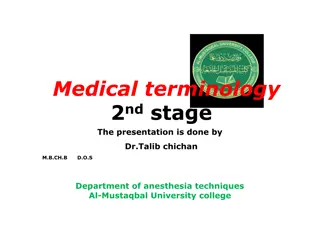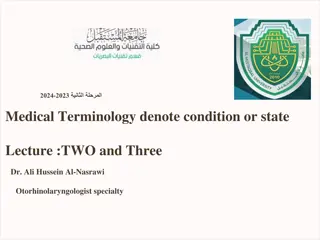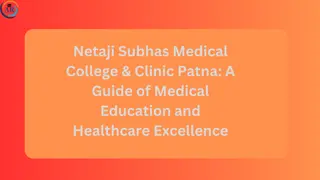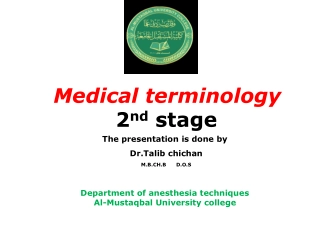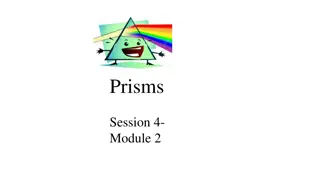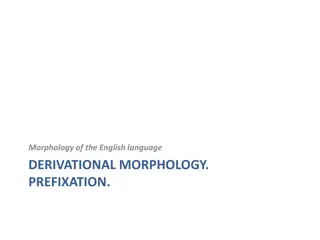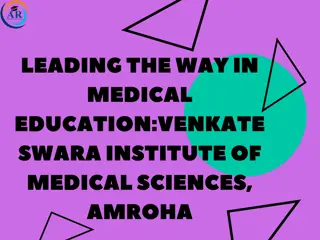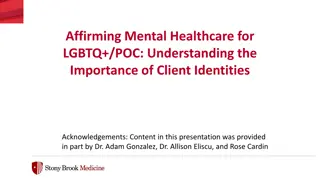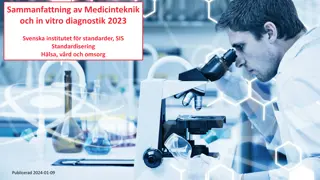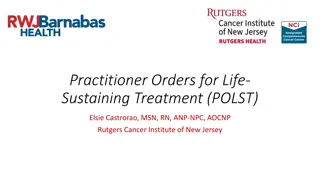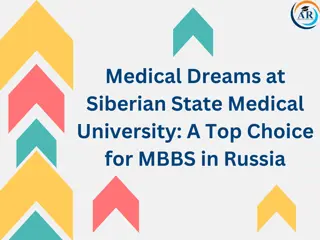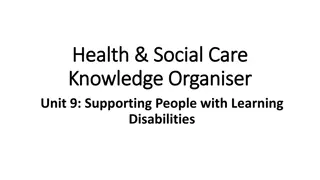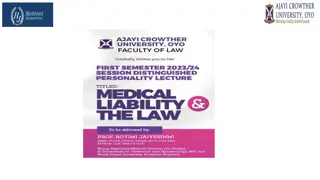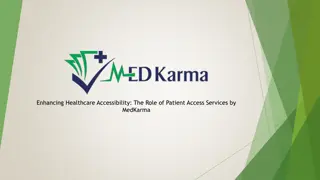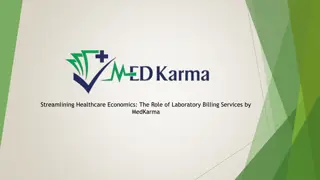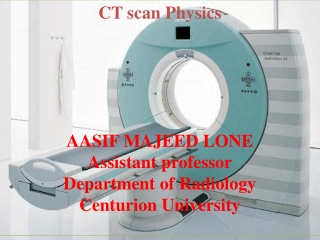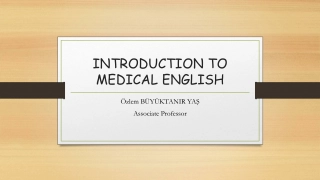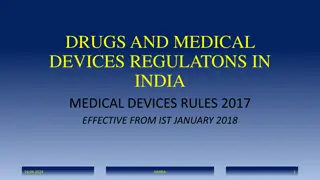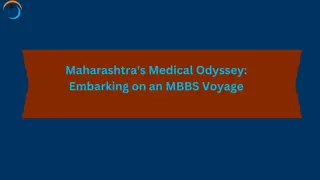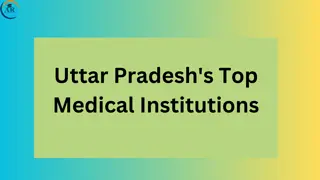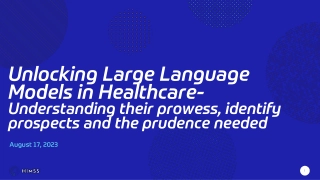Understanding Medical Terminology: Prefixes and Suffixes in Healthcare
Medical terminology involves compound words that define aspects of the body and diseases. This lecture covers the basics of medical terms, including word roots, combining forms, prefixes, and suffixes. Proper pronunciation is crucial in healthcare to avoid potentially life-threatening errors. Examples like "Cardiography" and "Pericarditis" illustrate how words are constructed and pronounced. Learning phonetic pronunciation helps in understanding and using medical terms effectively.
Understanding Medical Terminology: Prefixes and Suffixes in Healthcare
PowerPoint presentation about 'Understanding Medical Terminology: Prefixes and Suffixes in Healthcare'. This presentation describes the topic on Medical terminology involves compound words that define aspects of the body and diseases. This lecture covers the basics of medical terms, including word roots, combining forms, prefixes, and suffixes. Proper pronunciation is crucial in healthcare to avoid potentially life-threatening errors. Examples like "Cardiography" and "Pericarditis" illustrate how words are constructed and pronounced. Learning phonetic pronunciation helps in understanding and using medical terms effectively.. Download this presentation absolutely free.
Presentation Transcript
Prefixes and Suffixes By Dr. Huda Saad College of Dentistry /Mustansiriyah University
OBJECTIVES After completing this lecture and the exercises, the student should be able to: List the basic parts of a medical term. Define the terms word root, combining vowel, combining form, prefix, and suffix. State the rules for building medical terms. Divide medical words into their component parts. Build medical words using combining forms, prefixes, and suffixes. Use multiple-word roots in a compound word.
Medical Terms Medical terminology is a language of compound words matched together to define and condense phrases related to the human body, disease, and conditions. Misspellings and mispronunciations in a medical setting can result in life-threatening situations. A misspelled or a misunderstood abbreviation for a medicine dosage can have very serious consequences. People in health care must check and recheck verbal instructions.
Medical Terms Forming Medical Terms Many medical terms are formed from two or more of the following four basic word parts: 1. Word root is the portion of the word that contains its basic meaning. Example, the word root (cardi) means heart. 2. Combining forms are the word root and a combining vowel that connects or links two parts whenever two consonants come together. 3. Prefixes are word parts attached to the beginning of a word or word root that modify its meaning. 4. Suffixes are word parts attached to the end of a word or word root that modify its meaning.
Medical Terms Cardi o graphy Word root Suffix Combining forms /car-dee-OG-rah-fee/ Process of recording heart activity
Medical Terms Peri card itis Suffix Prefix Word root /peh ree kaa dai tuhs/ Inflammation of the pericardium
Medical Terms Phonics With medical terminology, sounds are not always pronounced the same as in everyday English pronunciation. One thing that helps in both the Standard English and medical worlds, is to learn how to pronounce phonetically by breaking up word sounds into smaller parts Peri card itis /peh ree kaa dai tuhs/ Inflammation of the pericardium
Medical Terms Pronouncing Common Prefixes and Beginning Sounds Terms beginning with the letters (ps) are pronounced with s sound Psychology /sigh-CALL-ogy/ science of mind & behaviour Terms beginning with the letters (pn) are pronounced with n sound /new-MOAN-ia/ Pneumonia infection of lung
Medical Terms Pronouncing Common Prefixes and Beginning Sounds Terms beginning with the letters (pt) are pronounced with t sound /TOE-sis/ Ptosis dropping of the upper eyelid
Medical Terms Pronouncing Common Prefixes and Beginning Sounds Terms beginning with (ch) often pronounced like k sound Chronic /KRON-ic/ long time illness Terms beginning with (c) or (g) can pronounced like s or j sound if come before i, e, y /SIGH-toe-plazm/ Cytoplasm /je-NET-ic/ Genetic Giant liquid fills the inside of a cell branch of biology, study of genes large /je-NET-ic/ But (c) and (g) have a hard sound before other letters. /CARD-iac/ Cardiac /GAS-trick/ Gastric related to heart adj. of stomach
Medical Terms Pronouncing Common Suffixes and Endings Singular and Plural Endings Many medical terms originate from Greek and Latin words. The rules for forming the singular and plural forms of some words follow the rules of these languages rather than English.
Medical Terms Pronouncing Common Combinations Some people like to look at the suffix first to determine if the term is a condition, a procedure, disorder, or disease. Once the suffix is defined, then move to the beginning of the word to define the prefix, if there is one, and the word root. This method is preferred by many people. Others prefer to tackle the term from the beginning, establishing a meaning for the prefix first, then moving to the word root, and to the suffix last of all.
Medical Terms Pronouncing Common Combinations Polyuria Oliguria /pol-ee-YOUR-ee-ah/ frequent urination /ol-ig-YOUR-ee-ah/ infrequent urination
Medical Terms Pronouncing Common Combinations Colotomy Colostomy /koh-LOT-oh-me/ Surgical cutting into the colon /koh-LOST-oh-me/ Surgical creation of opening in the colon
Prefixes Prefixes Related to Size and Quantity Prefix Meaning Example with pronunciation & meaning bi-, di- twice, bilateral [b -LAT-er- l] (both sides of the body) double half hemi- Hemiplegia [h m- -PL -j - ] (paralysis of half of the body) Microscopic [m -kr -SKOP-ik] (too small to see without a scope device) micro- small mono- monomania [m on- -M -n - ] (single thought or idea) one, single unilateral [y -n -L T- r- l] (one side of the body) single uni- multi- many multiarticular [MUL-t - r-T IK-y -l r] (many joints) poly- many polyarteritis [p ol- - r-t r- -t s] (inflammation of multiple arteries)
Prefixes Related to Position or Location Prefix Meaning Example with pronunciation & meaning sub- less than, under, inferior, below or beneath subcutaneous [s b-ky -T -n - s] (beneath the skin) supra- supramaxillary [s -pr -M K-s -l r- ] (above the maxilla) transdermal [tr ns-D R-m l] (across/through the skin) around, about, near periappendicitis [P R- - -p n-d -S -t s] (Inflammation surrounding the appendix) above, over, excessive across, through trans- peri-
The Human Body The human body is composed of cells, tissues, organs, and systems. These components are arranged into levels.
The Human Body The branches of science which cover the study of the body Anatomy: is the science that studies the structure of the body and the relationships of its parts to each other. Biology: is the study of all forms of life and living things. Embryology: studies the origin and the development of an organism. This covers from the 2ndto the 8thweek after conception (embryonic stage).
The Human Body The branches of science which cover the study of the body Histology: studies the body microscopically. The minute structures and their composition, plus the functions of normal cells, tissue, and organs. Physiology: studies the normal activity and functions of the body. Pathology: studies the changes caused by disease to the structures of the body or changes due to disease that alter the functions of the body.
The Human Body In making diagnoses or prescribing treatments, health care providers use standard terms to refer to different areas of the body. These terms describe each anatomical position as a point of reference. Directional Terms: are words used to describe the relative location of the body or its parts.
The Human Body Plane of the Body: is an imaginary flat field that is used as a point of reference for viewing three-dimensional objects. Anatomical planes divide the body into imaginary sections that are useful in describing the location of body parts relative to one another. Sagittal Frontal (coronal)
The Human Body Transverse
The Human Body The regions of the body are areas that have been named to give healthcare workers the ability to communicate possible problems that may be revealed during a physical examination.
In summary, the important elements of a medical term are: 1. Root: The foundation of the term 2. Prefix: The word beginning 3. Suffix: The word ending 4. Combining vowel: A vowel that links the root word to the suffix or to other root words 5. Combining form: A combination of the root word(s) and the combining vowel The rules for building medical words from these elements are: 1. A prefix is always placed at the beginning of the word. 2. A suffix is always placed at the end of the word. 3. When more than one root word is used, it is a compound word and requires the use of a combining vowel to separate the words, even if the root word begins with a vowel. 4. When defining medical terms, begin with the suffix and read backward. 5. If the word also contains a prefix, define the suffix first, prefix second, and root word(s) last. 6. When using compound words that relate to parts of the body, anatomic position determines which root word comes first.
Next LESSON TWO Progress Check Part A and B page 20-24 Chapter 11 Integumentary system




